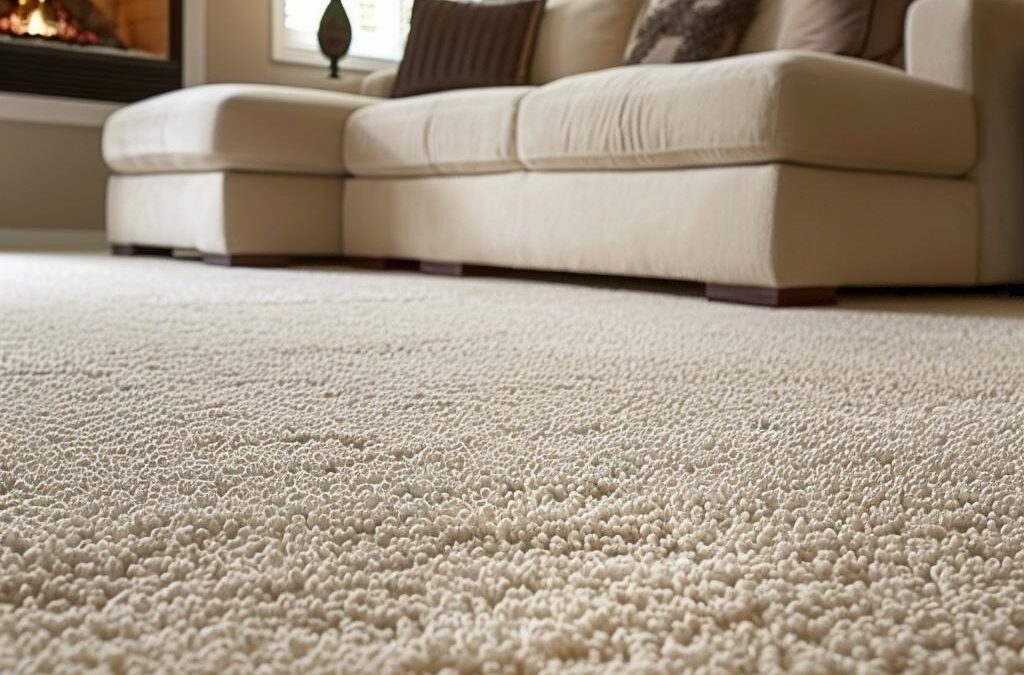The carpet underfoot is more than just a floor covering; it’s a foundational element of your home’s comfort, style, and atmosphere. It cushions your steps, dampens noise, and adds a layer of warmth that turns a house into a home. Yet, this essential piece of furnishing is also subjected to a relentless daily assault from dirt, spills, foot traffic, and the general wear and tear of life. Over time, these factors can prematurely age your carpet, turning a vibrant investment into a dull, stained liability.
This is where the often-overlooked hero of home maintenance steps in: carpet protection.
Often seen as an optional extra, applying a protective treatment to your carpet is, in reality, a critical strategy for preservation. It functions as an invisible shield, a proactive measure that drastically increases your carpet’s resilience and longevity. Understanding the science and comprehensive benefits behind this protective layer is key to maintaining a cleaner, healthier, and more aesthetically pleasing living space for years. We’re going to delve deep into why protecting your carpet isn’t just a good idea—it’s an absolute necessity—and how this simple step can deliver significant long-term value and peace of mind.
What Exactly Is Carpet Protection and How Does It Work?
Before we explore the benefits, it’s essential to understand the mechanism behind carpet protection. This process involves applying a specialized, non-toxic treatment that creates a microscopic barrier around the individual fibers of your carpet. It’s not a superficial layer that sits on the carpet; it bonds with the fibers, effectively making them resistant to external threats.
The Two Primary Forms of Protection
Carpet protection treatments generally fall into two categories, each with its own advantages:
-
Fluorochemical Treatments (Synthetic): These are the industry standard, often utilizing compounds like Teflon or Scotchgard. These chemicals are designed to create a very low surface energy on the carpet fiber. This causes liquids to bead up—a process known as hydrophobicity (water-repelling) and oleophobicity (oil-repelling). They form a robust, long-lasting barrier. The longevity and resilience of these treatments make them highly effective for busy households and commercial settings where durability is paramount. The technology behind fluorochemicals has advanced significantly, ensuring that modern formulations are safe for the home environment and environmentally responsible.
-
Natural or Plant-Based Treatments (Eco-Friendly): Increasingly popular, these alternatives use plant extracts and naturally derived substances. While sometimes less harsh on the environment, their longevity and effectiveness can occasionally be slightly lower than their fluorochemical counterparts, but they offer a great option for eco-conscious homeowners who prioritize sustainability. These natural options are constantly improving, offering a viable alternative without the use of harsh synthetic compounds.
The Science of the “Invisible Shield”
The magic of carpet protection lies in its ability to prevent two things: penetration and adhesion.
-
Preventing Penetration (Spills): When a spill occurs, the protective coating prevents the liquid molecules from soaking into the porous carpet fiber. Instead, the liquid maintains a high surface tension, forming a bead on top of the barrier. This critical delay, often called the “dwell time,” is what gives you a chance to blot up the spill completely before it has a chance to set and become a permanent stain. The high-surface tension created by the protector prevents capillary action, which is the physical process that draws liquid deep into the carpet’s backing and padding, often creating secondary stains or mildew issues.
-
Preventing Adhesion (Dirt & Wear): The coating also makes it difficult for dry soil, dust, and particulate matter to stick firmly to the fibers. This is important because it means that daily vacuuming becomes significantly more effective, lifting away the dirt that an unprotected fiber would otherwise tenaciously hold onto. Furthermore, by reducing the friction between fibers when they are crushed by foot traffic, the protective layer actively minimizes the physical damage and matting that leads to wear and tear.
By working on both the wet and dry fronts, the protective treatment ensures your carpet stays cleaner and experiences far less structural damage over time. It’s an investment in physics and chemistry that works tirelessly to preserve the textile structure of your flooring.
The Profound Benefits of Investing in Carpet Protection
The advantages of applying a high-quality carpet protection treatment extend far beyond simple stain resistance. They touch upon your home’s economics, your cleaning routine, and even the health of your family.
Exponentially Increases Stain and Spill Resistance
This is the most celebrated benefit. A protected carpet provides an immediate, stress-reducing safeguard against the inevitable accidents of daily life—the knocked-over glass of red wine, the coffee spill, or the muddy pet paw prints. The beading effect buys you precious time. It turns a potential disaster (a permanent stain) into a minor inconvenience that can be remedied with a simple blot and light cleaning solution. Without protection, a liquid can wick into the fiber’s core almost instantly, making professional stain removal a necessity, or worse, impossible. Even oil-based spills, which are notoriously difficult to remove, are repelled to a greater degree, allowing for easier extraction. This resistance is crucial for maintaining the aesthetic value of the carpet, especially in dining rooms and high-traffic communal areas where food and drinks are frequently consumed.
Dramatically Simplifies and Enhances Routine Cleaning
One of the most practical daily benefits is the transformation of your cleaning routine. Since dirt, dust, and dry soil are unable to deeply embed themselves into the protected fibers, they remain on the surface layer.
-
More Effective Vacuuming: Your regular vacuum cleaner becomes a powerhouse. Instead of requiring industrial suction to pull out stubborn, trapped dirt, vacuuming a protected carpet lifts significantly more soil with less effort. This improved efficiency means less time spent cleaning and less energy consumed.
-
Reduced Frequency of Deep Cleans: Because surface cleaning is so effective, the need for professional, restorative deep carpet cleaning is naturally reduced. The carpet stays visibly cleaner for longer periods between scheduled washes. The dirt that is pulled out of the carpet is primarily surface dirt, meaning the cleaner is truly restoring the fiber rather than struggling to pull out years of caked-in soil.
Routine cleaning transitions from a tedious chore to a quick, effective maintenance task.
Extends the Aesthetic and Structural Lifespan of Your Carpet
Daily foot traffic subjects carpet fibers to a constant grinding action. Dirt particles act like miniature sandpaper, scraping and fraying the delicate threads. The result is premature matting and fuzzing, which makes high-traffic areas look worn and discolored, even if they aren’t technically stained.
The protective coating acts as a physical buffer, significantly reducing the fiber-on-fiber friction and the abrasive action of trapped soil. This preservation of the carpet’s structural integrity means:
-
Delayed Matting: The plush texture remains intact for longer, maintaining the carpet’s original “new” feel and appearance. This is particularly important for deep-pile or Berber carpets where matting is highly visible.
-
Consistent Color: The original color retains its vibrancy because the fibers are shielded from abrasive wear and sun fading (many modern protectors include UV inhibitors). The protector helps keep the fiber clear and transparent, allowing the dye to reflect light properly, thus preventing the dull, gray look of heavily worn carpet.
-
Reduced Wear & Tear: The carpet simply withstands the rigors of family life—kids, pets, and entertaining—for a much longer duration. It preserves the warranty, as most carpet manufacturers require regular cleaning and sometimes recommend professional protection to keep their warranties valid.
Significant Long-Term Financial Savings
While carpet protection involves an initial cost, it delivers substantial long-term financial returns by offsetting multiple other expenses:
-
Reduced Replacement Costs: By doubling or even tripling the effective lifespan of your carpet, you delay the massive expense of purchasing and installing an entirely new floor covering. A quality carpet is a significant investment, and maximizing its life offers the greatest cost efficiency. The cost of a professional protection treatment is a fraction of the cost of a new installation.
-
Lower Cleaning Costs: Since routine vacuuming is more effective, and the carpet resists soil better, you won’t need professional cleaning services as frequently to restore its appearance. When you do clean it, the process is often faster and less labor-intensive for the technician, potentially saving you money on the service fee.
-
Fewer Spot Removal Treatments: Minimizing the number of permanent stains means you avoid paying for specialized stain removal services or purchasing expensive, high-strength cleaning chemicals. This reduces the risk of damaging the carpet fibers or bleaching the dye with harsh, over-the-counter products.
Carpet protection is an investment in preservation that guarantees you get the maximum value out of your original carpet purchase. It shifts the maintenance strategy from expensive restoration to cost-effective prevention.
Fosters a Healthier and Cleaner Indoor Environment
The health implications of carpet protection are often understated, yet vital, particularly for households with children, elderly residents, or allergy/asthma sufferers.
-
Minimizes Allergen Trapping: Carpets are notorious collectors of airborne allergens like dust mites, pet dander, and pollen. By making the fibers less ‘sticky,’ the protective barrier reduces the depth to which these micro-particles can embed themselves. This makes them easier to remove with standard vacuuming. For allergy sufferers, the ability to remove 90% or more of surface allergens through vacuuming, rather than leaving them trapped deep within the pile, is a significant health benefit.
-
Inhibits Mold and Bacteria Growth: A protected fiber is inherently less absorbent. This means that if moisture is introduced (from a spill or tracked-in snow), the area dries out faster. By reducing residual moisture, you significantly reduce the conditions necessary for mold, mildew, and harmful bacteria to proliferate. This is especially important in humid climates or basements.
-
Less Reliance on Harsh Chemicals: Because a protected carpet is easier to clean and resists deep soiling, you can rely on gentler, less aggressive cleaning solutions. This, in turn, contributes to better indoor air quality by reducing the emission of volatile organic compounds (VOCs) often found in strong cleaning agents.
A protected carpet contributes to a less dusty, less humid, and more hygienic living space, promoting overall well-being.
Key Considerations for Choosing and Applying Protection
To maximize the benefits of carpet protection, it’s important to approach the application with a discerning eye.
Professional vs. DIY Application
-
Professional Application: This is almost always the superior choice. Professional cleaners use high-grade, concentrated formulas that are not available to the general public. Crucially, they use professional-grade application equipment (like high-pressure sprayers) that ensure complete, uniform coverage of every single fiber—something nearly impossible to achieve with a can from the hardware store. Furthermore, professionals understand the specific type of carpet fiber (e.g., nylon, polyester, wool) and can select the best product for optimal performance and safety. They are trained to ensure the carpet is thoroughly cleaned and pH-neutralized before application, which is vital for the protector to bond correctly.
-
DIY Application: While cheaper upfront, consumer-grade sprays often provide lighter, less durable coverage. It’s easy to miss spots, leading to uneven protection and disappointing results in high-traffic areas. Attempting a DIY application can lead to over-saturation in some areas and zero coverage in others, resulting in patchy stain resistance.
When to Reapply
Carpet protection is not permanent. It is a sacrificial layer that wears down over time due to friction from foot traffic, the abrasive action of trapped soil, and the use of cleaning solutions (especially during professional deep cleaning).
-
General Recommendation: It is highly recommended to reapply protection immediately after every professional deep cleaning (shampooing or hot water extraction). A deep clean essentially strips away the existing protective layer, making re-application necessary to restore the shield. Most professionals suggest a reapplication every 12 to 18 months, depending on the level of foot traffic the carpet receives.
-
Testing for Effectiveness: You can easily test your carpet’s protection level by dropping a tiny bead of water in a low-traffic area. If the water beads up nicely, the protection is still working well. If it immediately soaks in, it’s time for a new coat.
Not All Carpets Are Equal
The effectiveness of protection can vary slightly based on the carpet material:
-
Nylon and Wool: These natural and semi-synthetic fibers are highly porous and accept protective treatments very well, showing excellent results in both stain and soil resistance.
-
Polyester and Olefin: These synthetic fibers are inherently more stain-resistant due to their chemical structure but often suffer from poor oil-repellency and rapid matting. They benefit greatly from protection to fight oil-based stains (like grease or cosmetics) and resist matting caused by traffic friction. A quality protector dramatically improves their performance in high-traffic settings.
Conclusion: Securing Comfort, Health, and Value
The decision to protect your carpet is fundamentally a decision to invest in the longevity and quality of your home life. It is a powerful, yet simple, form of preventative maintenance that offers a comprehensive suite of advantages spanning the aesthetic, the financial, and the hygienic aspects of your living space.
From the immediate, stress-reducing relief of knowing a spilled glass of juice won’t ruin your floor, to the long-term fiscal prudence of delaying an expensive carpet replacement, the benefits are undeniable. Carpet protection is the crucial step that preserves the “newness” of your flooring, making routine cleaning far more effective and, consequently, your indoor air healthier. It ensures that the money you originally spent on your carpet continues to provide comfort and beauty for the maximum possible duration.
Don’t treat protection as an optional extra; view it as a necessary component of responsible home ownership. By understanding the science and recognizing the profound benefits of this invisible shield, you empower yourself to secure the comfort, value, and cleanliness of your home for years to come.
For professional consultation and application of the highest-grade carpet protection available, ensure your investment is handled by experts. Carpet Care Solution provides top-notch services, ensuring your carpets remain in excellent condition. Get in touch today at (905) 819-0462 to learn more about how we can help you preserve the quality and longevity of your carpets.





